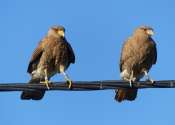Researchers engineer first sustainable chromosome changes in mice
Evolutionary chromosomal changes may take a million years in nature, but researchers are now reporting a novel technique enabling programmable chromosome fusion that has successfully produced mice with genetic changes that ...









